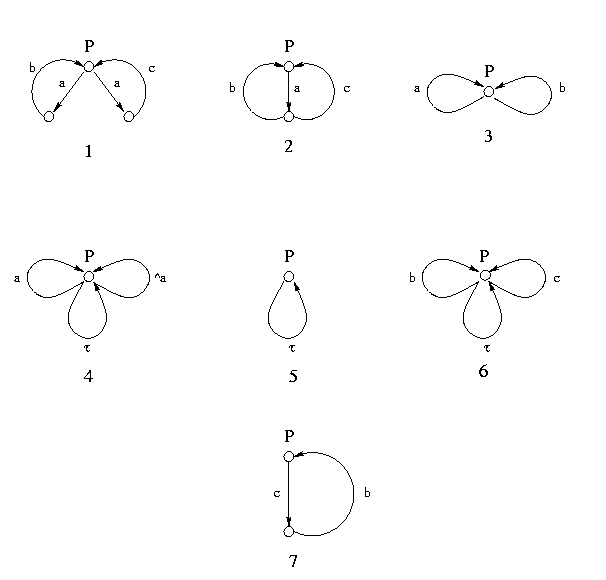Fall 2000, CSE 520: Solution of Assignment 5
Exercise 1

Exercise 2
- P and Q are neither strongly bisimilar, nor weakly bisimilar.
In fact P -a-> 0 while the only a-transition from Q brings to 0 + Q
which is not bisimilar to 0 (because 0 + Q can make an a-transition while 0 cannot make any
transition).
- P and Q are not strongly bisimilar because P can make a tau transition and Q cannot.
However P and Q are weakly bisimilar. A weak bisimulation between them is R = { (P,Q) , (0,0) }
- P and Q are strongly bisimilar and therefore also weakly bisimilar.
A bisimulation between them is R = { (P,Q) , (P|P, a.Q), (P|P|P, Q), (P|P|P|P, a.Q) ,... }
- P and Q are neither strongly bisimilar nor weakly bisimilar.
In fact, Q -a-> tau.c.0 + tau.d.0, while the only a-transitions that P can make
commits either to a process that offers only a c-transition or to a process that
offers only a d-transtion (after a tau-transition).
- In general P and Q are neither strongly bisimilar nor weakly bisimilar. In fact, is R is, say,
b.0, then P is able to make a b-transition after an a-transition,
while Q does not have this possibility.
Only if Q is equivalent to 0 then the two processes are strongly (and weakly) bisimilar.
Exercise 3
B2 and C are not strongly bisimilar, in fact C has some tau-transitions that
B2 does not have.
They are however weakly bisimilar.
A bisimulation between them is R = { (B2,C), (B1, (B'[out|->a] | B[in|->a])\{a}),
(B1, (B[out|->a] | B'[in|->a])\{a}), (B0, (B'[out|->a] | B'[in|->a])\{a}) },
where B' represents the process
B' =def= ^out.B.

